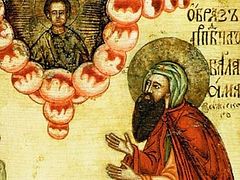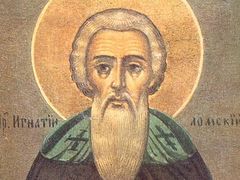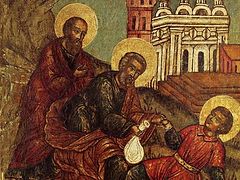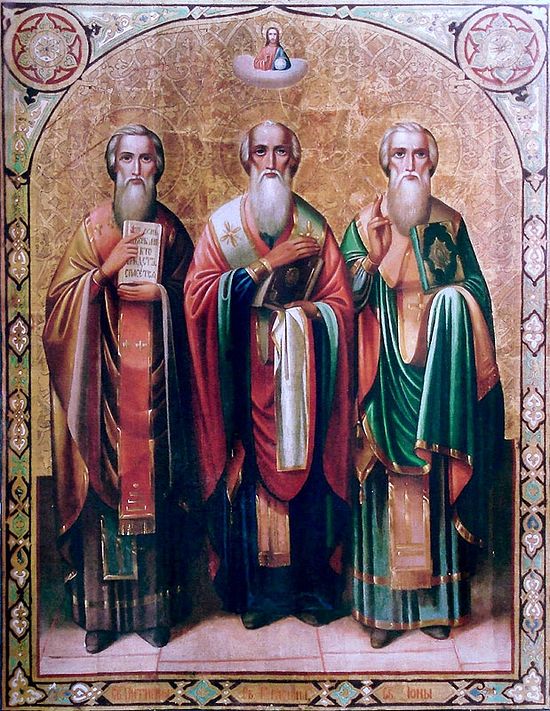 The Holy Hierarchs Gerasim, Pitirim and Jonah of Perm
The Holy Hierarchs Gerasim, Pitirim and Jonah of Perm
Here I am, O Lord, send me.
Here I am, O God, in good time.
And I shall glorify Thy Name,
Here I am, O Lord, here I am.
The labors of St. Stephen of Perm, who began the work of enlightening the Perm region, are engraved in its history forever. It was he, a friend and companion of St. Sergius of Radonezh, who laid the foundation of the Orthodox mission in Perm. Sailing on northern rivers, Stephen would preach on their banks and baptize and strengthen local inhabitants in Orthodox faith. He, an obscure monk, put the pagan high priest to shame, turned the hearts of common folk to himself and soon became the first bishop of a new diocese… But a human life span is not long, and the holy hierarch reposed long before his life’s work was completed.
Though the rays of Christ’s light did struggle through into the depths of the pagan forest, there were still many villages that, as before, had not yet heard the Gospel. Now, after the death of St. Stephen whom they hated, the pagan priests who were scattered across the Urals and had seemingly lost ground, hoped to get even with the newly-established Church of Perm. Among their plans were to bring their former flock back to the old beliefs, destroy the altars erected by St. Stephen, and resume their economic exploitation of the peace-loving Zyryans [“Zyryane”: the old-fashioned Russian name for the Komi—the people of what is now the Komi Autonomous Republic, belonging to the Finno-Ugric family.—Trans.]. Most of the shaman priests came from the Vogul people [“Voguly”: the obsolete name of the Mansi—the indigenous people living mainly in the Ob River basin in Western Siberia and related to the Finno-Ugric family; now most of them live in the Khanty-Mansi autonomous area within Russia’s Tyumen region.—Trans.] who converted to Orthodoxy very reluctantly.
The new diocese’s link to the Moscow Metropolis seemed (and was in many respects) nominal and illusory; in the late fourteenth century it was still extremely far from there to the Grand Prince (and the Metropolitan) of Moscow. The defenselessness of local clerics in the face of a hostile and often aggressive population frightened the newly-arrived priests and jeopardized the clergy who were Zyryan converts. Moreover, the new diocese needed not just priests but missionaries who were ready to put their lives at risk in open conflicts with the rebellious Ostyaks (the Khanty and the Mansi). It needed monks who were not bound to their families and children. This caused a shortage of clergy.
Another threat came from local government officials (zemsky dyaks) who as secular masters were gradually taking over the authority of bishops who governed the huge territory. This territory fell under the patronage of the Grand Prince of Moscow primarily under the auspices of the religious solidarity of Moscow and the newly-converted people of Perm, but the laws of the development of Muscovy demanded rendering to Caesar the things that are Caesar's, and sometimes these demands took cruel and even bloodthirsty forms.
The Archbishopric of Novgorod was indignant with Moscow, believing that the self-seeking Muscovites had lawlessly appropriated the territories that had belonged to the See of Novgorod from time immemorial1. Thus, some dishonest Church figures from among the ambitious lobbyists for Novgorod imperialism were ready to help the pagans who resisted the Muscovite expansion.
Thus St. Stephen’s work was threatened with serious danger. However, leaving the people of Perm physically, the holy hierarch had promised to remain with the Zyryans spiritually after his repose, provided they remain faithful Orthodoxy and keep their love for it. That is why after his repose, missionary work in his diocese was continued by three worthy successors: Sts. Gerasim, Pitirim and Jonah.
But Isaac, St. Stephen’s immediate successor in the diocese of Ust-Vym 2, spent most his archpastoral ministry in Moscow, because being close to senior representatives of the Church hierarchy was his top priority as a hierarch. It is unknown whether his intercessions with the Metropolitan for the newly-converted Zyryans were successful; but what is known is that the name of Isaac was all but forgotten in the annals of Perm history, and his memory was almost erased and replaced by his immediate successors’ missionary exploits; because they preferred to share in the sorrows and joys of their flock in situ rather than send them exhortations from faraway Moscow.
St. Gerasim, the betrayed and murdered bishop
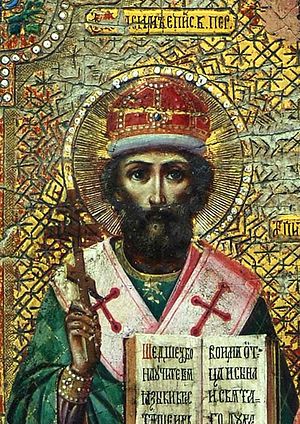 Hieromartyr Gerasim The first hierarch to be canonized by the people of Perm after St. Stephens’ death and declared as a wonderworker was St. Gerasim, who served as Bishop of Perm between 1418 and 1443. His tenure coincided with a difficult period: In 1418, 1422 and 1423, Rus’ was stricken with famine; and the first half of the fifteenth century was marked by devastating epidemics, which wiped out entire villages and even towns. 1432 saw the beginning of an internecine war between the heirs of St. Dimitry Donskoy which caused the deaths of numerous civilians: “As long as there was strife, a lot of innocent Christian blood was shed3.” Throughout that period St. Gerasim headed the mission among the Vogul people and at the same time took measures to reinforce the diocese boundaries against their attacks. According to N.B. Rogachev’s observations, St. Gerasim, “using the authority given by the Grand Prince, executed administrative and political governance, held diplomatic negotiations, acted as a judge, and was involved in the defense of the region4.”
Hieromartyr Gerasim The first hierarch to be canonized by the people of Perm after St. Stephens’ death and declared as a wonderworker was St. Gerasim, who served as Bishop of Perm between 1418 and 1443. His tenure coincided with a difficult period: In 1418, 1422 and 1423, Rus’ was stricken with famine; and the first half of the fifteenth century was marked by devastating epidemics, which wiped out entire villages and even towns. 1432 saw the beginning of an internecine war between the heirs of St. Dimitry Donskoy which caused the deaths of numerous civilians: “As long as there was strife, a lot of innocent Christian blood was shed3.” Throughout that period St. Gerasim headed the mission among the Vogul people and at the same time took measures to reinforce the diocese boundaries against their attacks. According to N.B. Rogachev’s observations, St. Gerasim, “using the authority given by the Grand Prince, executed administrative and political governance, held diplomatic negotiations, acted as a judge, and was involved in the defense of the region4.”
St. Gerasim’s self-sacrificing missionary endeavors, along with his consistent and energetic policy in the administrative sphere not only set the region’s development on the most progressive path but also provoked the envy of the less talented or charismatic functionaries of the state machine. The latter, wishing to get even with St. Gerasim who, in their view, exceeded his authority, decided to make use of the Vogul people’s deadly hatred for him. Officially, the local government officials who acted in collusion were right—St. Gerasim organized “groundwork at the bishop’s residence for the construction of a church” and entered into “conflict with the prince’s administration over disputed land ownership.”5 In all probability, the bishop wanted to expand his estate (the bishop’s settlement [vladychny gorodok.—Auth.] on the territory of which a bishop was equal to a feudal lord) without the secular authorities’ permission and get a part of the population involved in the work (compulsory but made to appear voluntary) on renovating a dilapidated church in Ust-Vym.
What made St. Gerasim firmly demand obedience to himself of the Prince of Moscow’s subjects in matters that were subject to Church jurisdiction? The fact is that the holy bishop presumed “in all fairness” Moscow government officials’ progress, along with cultural development and improvement in living conditions of inhabitants of humble Zyryan villages were the direct and immediate result of the success of Orthodox mission; and, therefore, there was nothing more important both for Moscow functionaries and local pastors than expanding the territory around the bishop’s residence and repairing the crumbling church.
But St. Gerasim’s opponents thought otherwise. Through slander they made a member of his household, a baptized Vogul, begin to hate him, and persuaded the man to murder the bishop for patriotic reasons, standing up for his people whom St. Gerasim supposedly persecuted. The most cynical thing about this treacherous murder was that it was committed by someone whom the saint had once taken into his home for care and for spiritual guidance. According to St. Gerasim’s plan, this Vogul would have eventually become a pastor and a missionary among his fellow-tribesmen.
On that fateful day, during a prayer service, the madman waited until St. German turned his back, grabbed his omophorion and strangled him with it. This is how the Vychegda-Vym Chronicle, written by the clergy of the Ust-Vym Monastery of the Archangel Michael in the late sixteenth century, recounts his tragic murder: “Bishop Gerasim of Perm has been murdered several stadia [an ancient measure of length, about 185 meters.—Trans.] from the bishop’s settlement, in the place called Mys6.”
St. Pitirim the Martyr
A spiritual brother and follower of Sts. Stephen and Gerasim, St. Pitirim the Wonderworker rightly divided the word of truth (cf. 2 Tim. 2:15) in the diocese of Ust-Vym from 1444 till 1455. Although numerous fires destroyed most of the written evidence of the history of the Perm Diocese, many details from the biography of this distinguished Church figure of the age, who lived an extremely eventful life, survive. “This holy man came from the God-protected city of Yaroslavl God in Great Rus’.” St. Pitirim was raised by pious parents, in his youth abandoned the world with its temptations and was trained in the path of monastic perfection under the guidance of “a great elder named Kirill.” Soon the young monk ended up at Moscow Chudov Monastery [in honor of the Miracle of the Archangel Michael.—Trans.] where he was first ordained a priest and then elevated to the rank of archimandrite, becoming an instructor to the younger brethren: “He was also abbot of a monastery where many monks struggled; he travelled a lot to other monasteries, instructing and giving spiritual care to their brethren, teaching the way of God in accordance with the truth (cf. Mk. 12:14).” Throughout his life St. Pitirim especially honored the memory of the holy Metropolitan Alexei of Moscow, the founder of monasteries within the Moscow Kremlin, and later as the bishop of Perm he composed his Life and a canon of praise to him.
Chudov Monastery was known as the royal monastery, and its abbot would become a close advisor to the Grand Prince of Moscow. As abbot of Chudov Monastery St. Pitirim may have baptized the future Grand Prince Ivan III of Russia (1462—1505) in infancy, and after the news of the martyrdom of St. Gerasim of Ust-Vym had reached Moscow, the Metropolitan chose him as candidate, not without the influence of, or rather, on the initiative of the Grand Prince. St. Pitirim must have been shocked by St. Gerasim’s martyrdom; there was invisible warfare on the metropolia’s eastern frontiers, and representatives of the senior Moscow clergy were becoming its victims. By that time the fratricidal war between Princes Vasily II the Blind and appanage Prince Dmitry Shemyaka was already raging in Rus’. Its battlefront was precisely in Perm, and the bishopric couldn’t avoid “hostilities”. The future holy hierarch willy-nilly had to engage in bigtime politics. Well aware of this, he consciously and readily took the bishop’s duties on himself with humility and made his way to St. Gerasim’s bereaved flock.
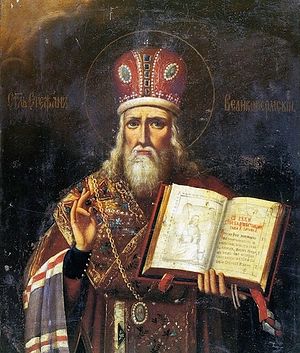 St. Stephen, Bishop of Great Perm St. Pitirim’ activity in the diocese of Ust-Vym was primarily missionary by nature. The hierarch was seldom in his cathedral, and the clergy of the bishop’s quarters simply couldn’t allow themselves to lead a settled way of life, because St. Pitirim was at his Annunciation Church permanently only in the first months of his archpastoral ministry. With the boldness characteristic of his education, erudition and energy, St. Pitirim didn’t take up missionary work until he had considered all the pros and cons of the campaign, the conditions, all the difficulties and risks, prospects and possible obstacles on its path.
St. Stephen, Bishop of Great Perm St. Pitirim’ activity in the diocese of Ust-Vym was primarily missionary by nature. The hierarch was seldom in his cathedral, and the clergy of the bishop’s quarters simply couldn’t allow themselves to lead a settled way of life, because St. Pitirim was at his Annunciation Church permanently only in the first months of his archpastoral ministry. With the boldness characteristic of his education, erudition and energy, St. Pitirim didn’t take up missionary work until he had considered all the pros and cons of the campaign, the conditions, all the difficulties and risks, prospects and possible obstacles on its path.
In those first months, scrupulous analytical work to determine the strategy for future missionary work was carried out in the bishop’s office, St. Pitirim’s desk was covered with maps that he and his companions had drawn and marked. Long-time residents of the bishop’s quarters from among the clergy who had concelebrated with St. Gerasim reported to St. Pitirim what, when and how the people of Perm had been evangelized, in which districts of the region the inhabitants were the least enlightened by the missions of Sts. Stephen, Gerasim and their disciples, and where the pagan high priests whom St. Gerasim exposed had fled. It was finally decided to start a missionary campaign in the area of the Vashka basin, settled by the Udoren people. It was there, in the area called Udora, that the bastion of paganism (contemporary to St. Pitirim) was concentrated; it was there that the spiritual leaders of idol-worship and their followers had settled after being banished by St. Stephen several decades before.
By his personal example St. Pitirim instructed his priests how to find words that would reach the hearts of ordinary people. Those were the words of consolation and support, words that really staggered a populace who lived by the laws of vendetta and in the wildest pagan ways: “And he baptized and converted many, since those people were ignorant and notorious for their cruel customs; the blessed man enlightened and taught them in faith with great humility.” According to the Vychegda-Vym Chronicle, the success of the mission was full and unconditional: “Bishop Pitirim converted the Udoren people at the Vashka River to the holy faith, gave them abbots and priests, and erected holy churches there.”
Wandering across his diocese’s outlying districts, the holy bishop didn’t forget the people of Perm who made up the heart of his flock. St. Pitirim would often give targeted support to residents of Zyryan settlements, generously distribute alms from his private sources, and, most importantly, intercede with the Grand Prince to reduce the amount of tribute the people of Perm were obliged to pay.
Over his tenure the holy bishop visited Moscow several times to take part in the events that would be epoch-making for his contemporaries. The first of them was associated with the Synod of the Russian Bishop’s anathema of Prince Dmitry Shemyaka, who had blinded Grand Prince Vasily II of Moscow (1425–1462) in order to seize power and remove his most dangerous and legitimate rival from the political scene. It is remarkable with what unanimity Church figures (monks, like St. Gregory of Pelshem, as well as bishops) took Prince Vasily’s side in this political struggle.
Later, the modern historian Alexander Zimin (1920–1980) would say that Shemyaka fell victim to his own defeat. If the outcome of that conflict had been different, history with its historiographers would have taken his side7. However, the rigor of the hagiography’s heroes casts serious doubts on this hypothesis. The White Lake Monastery elders allowed Vasily to break his vow of not laying claim to Moscow, giving him full freedom to act. The Church hierarchs came to the capital occupied by Vasily to demonstrate their loyalty to him. One of the senior Church representatives of great authority who showed unconditional support for Vasily was Bishop Pitirim. He knew like no one else how much suffering Shemyaka’s ruinous campaigns had caused ordinary Russian people. Engaging the Perm Diocese’s most hardened enemies (the Vogul people and the inhabitants of Vyatka) for his purposes, Shemyaka scored repeated successes in his acts of banditry—blood was shed, and people in St. Pitirim’s flock were dying. Later Shemyaka took vengeance on the people of Perm by executing the Perm captains Emelka Luzkov and Euphemius Ezhvin for their willingness to fight on the side of the people of Veliky Ustyug, whose lands were being ravaged by his regiments8.
A few years later, Bishop Pitirim preached to the people of Vyatka who had cooperated with the rebellious prince’s excessive ambitions, and his words had a direct effect: Having laid siege to Ust-Vym in 1450, the Vyatchane’s army suddenly withdrew, leaving the town intact. The population of Perm remained indifferent to Dmitry’s calls. Everything seemed to indicate that the prince’s cherished ambitions were crumbling to dust, and the uncompromising and energetic Bishop Pitirim had largely contributed to that.
Shemyaka was determined to capture the bishop during one of his trips and by means of persuasion or promises force him to repeal the anathema against him. It remains unknown whether Dmitry hoped that psychological contact and mutual understanding might come during their talk tete-a-tete, or whether he believed in his own powers of persuasion, or had prepared some arguments which would justify his aggressive policy in the lands of Russia’s north, or perhaps meant to influence the bishop by threats and promises.9 In any case, his main aim was to win St. Pitirim over.
This is how the Vychegda-Vym Chronicle describes this event: “In 6960 (1452) the cursed Shemyaka caught Bishop Pitirim on his way to Moscow, brought him to Ustyug, put him in jail and tortured him there; but the hierarch stood firm and did not repeal his anathema.” While in Ustyug in 1452, Dmitry followed all the movements of the Russian Church’s authoritative hierarch closely; and as soon as one of the prince’s spies reported St. Pitirim’s scheduled trip to Moscow, with the departure date and accompaniment (the bishop preferred to travel light, caring more about speed of travel than safety), Shemyaka didn’t fail to make use of such favorable circumstances.
St. Pitirim spent several months in confinement. Since the bishop yielded to no persuasion and flattering promises had no effect (Shemyaka saw in St. Pitirim a severe exposer of his heinous crimes, personal cruelty and dissoluteness), the prince’s arguments took another turn: he considered a prison cell, short rations, and threats of reprisal to be faster and safer means than heart-to-heart talks and attempts at self-justification. But that was in vain: St. Pitirim’s thoughts, words and deeds were only: “I am ready to die.” And St. Pitirim would have done his archpastoral duty and shown the cunning prince that he would not find the bishop to be a reed shaken with the wind (Lk. 7:24). However, this time God saved His servant’s life: The Muscovite army that was moving towards Uglich forced Dmitry to hastily retreat to Veliky Novgorod—the last bastion of anti-Moscow sentiment. St. Pitirim was released and resumed his archpastoral ministry with new enthusiasm.
The most important event St. Pitirim took part in was the Church Council of 1448 at which the Metropolitan of Moscow was elected and his appointment was confirmed without the Patriarch of Constantinople’s approval, for the first time in several centuries. In effect, the approval of the Synod of Russian Bishops of Bishop Jonah of Ryazan as the Metropolitan of Moscow meant the beginning of Russian autocephaly. This event seemed uncanonical to many hierarchs of the age, and the legitimacy of Jonah was questioned. Under the current circumstances (the falling away from Orthodoxy of Constantinople’s protégé Isidore, disorder in the Byzantine Empire) St. Pitirim couldn’t remain indifferent and expressed his stance with his characteristic straightforwardness and firmness: There shall be Russian autocephaly! With all the disadvantages that “breaking the cord” (connecting the Russian Church with Constantinople) entailed, now there was no alternative.
St. Pitirim’s life ended at the height of his archpastoral activity. Many years before, when he was being consecrated, standing by the gravestone of his predecessor in the Perm diocese St. Gerasim, St. Pitirim had been well aware that he could hardly expect a peaceful repose on his bed, surrounded by grateful disciples. The archpastoral ministry in a Perm that had not yet submitted to the Prince and the Metropolitan of Moscow was fraught with risks. On August 19, 1455, soon after a successful missionary journey to Great Perm and Cherdyn, after the end of the Sunday Liturgy at the Church of the Annunciation in Ust-Vym, St. Pitirim together with other clergymen and parishioners headed for a field between the Vym and the Vychegda to hold a prayer service10. But several miles away the Vogul Prince Asyka and his son Yushman were lying in ambush. Perhaps they decided to get even with St. Pitirim for baptizing the Vogul people living along the Pechora River, or they just seized the opportunity to make short work of their long-time antagonist in the person of the Bishop of Perm during another raid: “They were angry with the holy father because, contrary to their wishes, he tried his best to convert pagans to Orthodox faith and baptize them11.”
According to one version, some of the Vogul people found out about St. Pitirim’s plans by making inquiries with someone from a group of “heathen” who “had sailed up the Vychegda for a certain undertaking… in five days’ walk distance, in the place called Yur12.” When the whole procession appeared in the field of vision of Asyka’s detachment, the heathen rushed towards the defenseless worshippers from their hiding. Seeing the enemy, the holy bishop instantly ordered his companions to escape, hoping at the cost of his life to cover their retreat to the fortifications of Ust-Vym. St. Pitirim realized that he was the main target of the heathen attack and it was unlikely that his flock would be pursued. The holy hierarch met his death without murmuring, without making any attempts to defend himself: “And, seizing the saint with fury, they took turns beating him, tormenting him and putting the innocent man to death.” 13 The bishop’s body, which lay unburied for forty days, remained incorrupt, and his relics were enshrined at the Church of the Annunciation in Ust-Vym to the left of St. Gerasim’s shrine.
St. Jonah, baptizer of Great Perm
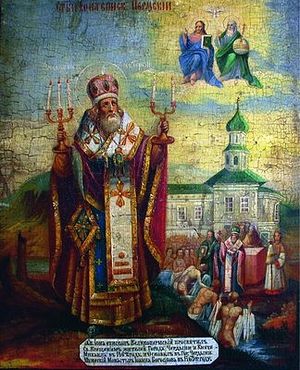 Holy Hierarch Jonah of Great Perm In 1456, St. Jonah was installed as bishop of Perm. Like his predecessors, St. Jonah was above all a balanced politician, a pragmatist and well understood that the salvation of the souls of hundreds, if not thousands, of unbaptized indigenous people depended on his spiritual care. Soon it became clear to the holy bishop that the eastern part of his huge diocese of Perm left much to be desired; most of the people who had not yet accepted the Gospel truth lived in or near Great Perm. Despite the need to spend several years in Moscow (on his deathbed Metropolitan Jonah of Moscow entrusted his namesake with the important mission of announcing to the Synod of Bishops his will in the election of his successor to the Metropolia of Moscow), in 1462 Bishop Jonah organized a kind of “crusade” to Great Perm under the cover of the Moscow army sent by Prince Ivan III to Vyatka to suppress the Cheremiss [the obsolete Russian name for the Mari—an Ugrian people of the Volga region, especially of what is now the Mari El Republic in Russia.—Trans.]. As a result the holy bishop managed to convert a prince of Perm to Christianity, and the latter was baptized with the name Michael. And in a matter of months St. Jonah’s preaching reached its target with Prince Michael’s help: “In the same year Bishop Jonah baptized Great Perm, built them churches and gave them priests.” 14
Holy Hierarch Jonah of Great Perm In 1456, St. Jonah was installed as bishop of Perm. Like his predecessors, St. Jonah was above all a balanced politician, a pragmatist and well understood that the salvation of the souls of hundreds, if not thousands, of unbaptized indigenous people depended on his spiritual care. Soon it became clear to the holy bishop that the eastern part of his huge diocese of Perm left much to be desired; most of the people who had not yet accepted the Gospel truth lived in or near Great Perm. Despite the need to spend several years in Moscow (on his deathbed Metropolitan Jonah of Moscow entrusted his namesake with the important mission of announcing to the Synod of Bishops his will in the election of his successor to the Metropolia of Moscow), in 1462 Bishop Jonah organized a kind of “crusade” to Great Perm under the cover of the Moscow army sent by Prince Ivan III to Vyatka to suppress the Cheremiss [the obsolete Russian name for the Mari—an Ugrian people of the Volga region, especially of what is now the Mari El Republic in Russia.—Trans.]. As a result the holy bishop managed to convert a prince of Perm to Christianity, and the latter was baptized with the name Michael. And in a matter of months St. Jonah’s preaching reached its target with Prince Michael’s help: “In the same year Bishop Jonah baptized Great Perm, built them churches and gave them priests.” 14
Over the course of St. Jonah’s tenure in the bishopric of Perm the political situation in the region considerably improved: Moscow, in the person of Vasily the Blind and his heirs, completely crushed the opposition of local pagan princelings who would gather savage hordes to lay waste to peace-loving Zyryan towns and villages, along with the envious raiding bands of Novgorodians15 (in fact no less pagan) who threatened the region’s development. The prayers of the holy men were answered, and St. Jonah died in advanced old age with a sense of accomplishment: The clouds that had been gathering over St. Stephen’s legacy were scattered by the labors and prayers of the holy men. “What lies in store for Perm?” the venerable elder Jonah asked himself on his deathbed in 1472. But the answer didn’t come immediately: New Christians would be born; they too would pray to Christ in this land and in the churches consecrated by him and his predecessors, after his death, after the death of his successor, and so on till the end of time. St. Jonah’s remains were laid to rest in the shrine containing the relics of Sts. Gerasim and Pitirim.
The the ministry of these three holy hierarchs of Perm who contributed to the enlightenment of the pagan tribes in northeastern Russia’s border regions in the fifteenth century is a story of how at the right time and place, there were men found in the Russian Church who fearlessly answered the Lord’s call, Whom shall I send, and who will go for us?: Here am I; send me (Is. 6:8).

